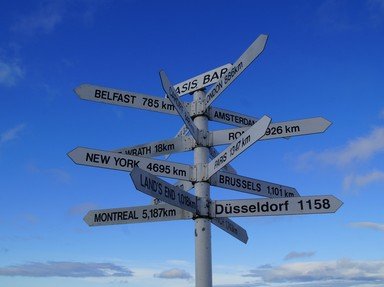Quiz Answer Key and Fun Facts
1. Starting from the city in the Netherlands where yours truly was born:
"VLPIA NOVIOMAGVS BATAVORVM"
Built against the hills on the banks of the river Waal (a distributary branch of the Rhine river), this city was established as a Roman army camp around the year 5 AD and claims to be the oldest city in the Netherlands. Where am I?
[HINT: Operation Market Garden]
2. I'm still walking to Rome in Roman times...
Going south from the oldest city in the Netherlands, Vlpia Noviomagvs, I walk though the gentle rural landscape of Limburg province until I'm finally close to what we would now call the Belgian border. I stumble upon a sign that says:
"MOSA TRAIECTVM"
Scrambling to recall my Latin lessons from so many years ago, I translate this sign as "Crossing of the Meuse (or Maas) River". Where am I?
[HINT: EU Treaty 1992]
3. I'm still walking to Rome in Roman times...
After my visit to what is now the Netherlands' most southern province, I cannot resist the opportunity to venture some 30 km eastwards into (21st century) Germany to visit the wholesome hot springs of:
"AQVÆ GRANNI"
Where am I now?
[Hint: Carolus Magnus]
4. I'm still walking to Rome in Roman times...
The soles of my feet are itching. I get on the road again and hike some 150 km southwards from the westernmost city of (21st century) Germany through beautiful hilly scenery, until I finally crest a hill and see a valley with a town built on the banks of the river Moselle. Directing my steps towards this settlement, I soon stumble upon the following sign:
"AVGVSTA TREVERORUM"
Still in (21st century) Germany, in which "Kapital" city am I now?
5. I'm still walking to Rome in Roman times...
Finding my pace, I head southwest from the oldest city in (21st century) Germany and visit the most important city of the Roman province Gallia Belgica:
"DVROCORTORVM"
Despite its origins as capital of the Belgian province, this city is not in Belgium, but happens to be the main center of the precious French Champagne region. Salut! Where am I now?
6. I'm still walking to Rome in Roman times...
Southwards! The champagne region was splendid, but now I long to take in the beauty of the Notre Dame on Île de la Cité and rest on the banks of the Sequana river. Alas, or as a Roman would say: Heu! The cathedral has yet to be built, so I have to make do with just the river banks when I enter:
"LVTETIA"
Where am I now?
Oh la la, no hint?
7. I'm still walking to Rome in Roman times...
Refreshed by the sights and sounds of Lvtetia in the north of (21st century) France, I retrace my steps back to the Via Agrippa (those Romans sure know how to build roads!) and set course due southeast. After quite a long haul I see the capital of Gaul or Gallia in the distance:
"LVGDVNVM"
Founded in 43 BC, this important Roman city at the confluence of the Rhône and Saône rivers was the birthplace of two Roman emperors, Claudius and Caracalla. Where am I now?
8. I'm still walking to Rome in Roman times...
Temperatures are rising noticeably in the south of France, so I'm impatient to get to the Mediterranean Sea or as the Romans so humbly call it: Mare Nostrum (Our Sea). I pass endless lavender fields and vineyards, set on gentle hills, until at last I feast my eyes on blue waters stretching to the horizon. From a distance I can make out a nice harbour town and soon enough there is a sign:
"MASSILIA"
Where am I now?
9. I'm still on my way to Rome in Roman times...
My feet are killing me! I must have hiked some 1,400 km since my departure from my home town to the sandy beaches of the Mediterranean Sea and don't want to go on on foot. In the harbour I ask around and manage to secure passage aboard a navis oneraria (merchant ship) setting sail towards:
"CALARIS"
I have never heard of this city, but the captain explains that it is a former Carthaginian stronghold on the southern shores of the island Sardinia. Where am I headed?
10. I'm still on my way to Rome in Roman times...
Having enjoyed the Sardinian hospitality and sights so much, I find it hard to say my farewells and board another ship for the last eastbound stage of my trip. I watch the island dissolve in the distance and after a few days at sea (and an easy few kilometers on the road), I'm finally entering the eternal city! Mesmerized by the sheer vastness and abundance of the greatest city in the world, I pass the sign:
"ROMA"
Now, you already know where I am, but in which nearby harbour town, some 25 km southwest of Rome, did I alight from my ship?
Source: Author
Debarrio
This quiz was reviewed by FunTrivia editor
spanishliz before going online.
Any errors found in FunTrivia content are routinely corrected through our feedback system.
